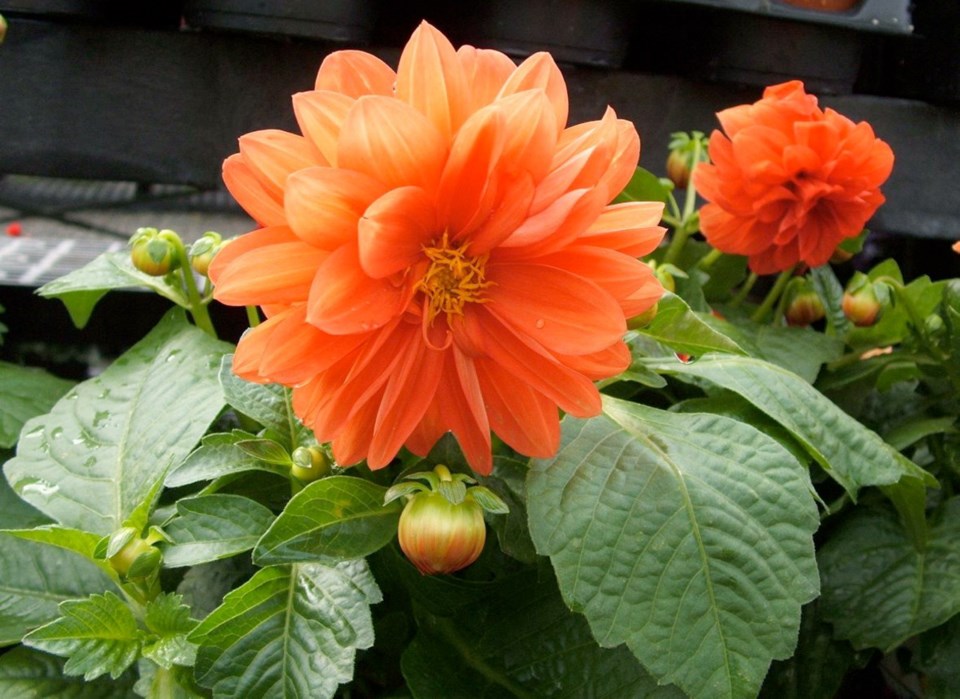Dear Helen: When is the best time to divide dahlias? I’ve heard it can be done in either spring or fall. Do you have a preference?
A.D.
I prefer to divide clumps of dahlia tubers in the spring.
Because my soil is light-textured and fast-draining, and not host to heavy populations of root-nibbling insect pests, I leave the roots in place for the winter, mulched generously with soil and wood shavings. Every two or three years I lift the clumps in spring to divide and replant.
Where soils are significantly infested with wireworms, or the ground stays soggy in winter, it is wise to lift the clumps in mid-autumn and store them until spring. When winters were colder I used to lift and store dahlias. Even then, I waited until spring to divide them. I found that clumps left intact stored better, and in the spring it is easier to spot the location of new growing points, or “eyes” around the old stem area.
Leave a slight stem stub on each lifted clump and make sure it is clearly identified with a label. Line deep cardboard boxes with plastic and newspaper for the clumps, and surround them with vermiculite. Wood shavings or sawdust can also be used. Store in cold but frost-free conditions, ideally around 5 C.
In the spring, as tiny nubs of latent growth show clearly, make sure that each tuber you choose to replant has one of these “eyes” to grow into a new plant. Leave the cuts to dry before planting. Or, rub them with powdered sulphur.
Dear Helen: I’m curious to know what sort of adjustments you have made or plan to make in your planting and gardening in general in light of the past summer’s conditions and weather patterns that point to longer, hotter summers to come.
D.F.
I began experimenting this year, with the length and heat of summer 2014 in mind. Instead of my usual two double rows of peas I planted just one, with the intention of making a second sowing in July as soon as the March seeding had finished producing. I was thinking that we may be entering an era of two summers rolled into one.
It didn’t work. The first planting began producing but fizzled in the intense heat of July. The second planting began well and the heat was less fierce in August, but the watering became difficult in the latter part of the summer. The crop was not great.
What did I learn? I’ll be watching the weather carefully in February, with a view to seeding around three weeks earlier than usual, in late February to early March. And I’ll seed the two double rows, in hopes of harvesting a good crop of peas before the hottest weather. A deep watering and mulching in May to early June will help.
I’m aiming for earlier spring seedings, indoors and out, and an expanded array of fall and winter vegetables in view of the warm, sunny weather that extended far into autumn this year.
The root vegetables — carrots, parsnips, beets — were all fine. these are not demanding vegetables. Neither are beans, though runner beans often have problems in high heat. Plant them earlier than other beans.
If next summer is like the one past, a key issue will be finding ways to retain moisture in the soil. I must admit that, by late summer, I began to down tools in the watering department. The looming expense was daunting, and my longstanding easy relationship with the garden hoses had become strained.
I mulched with straw last year, but I’m planning to enhance mulching for drought-vulnerable food crops next year by spreading compost around the plants, watering deeply, and then placing several layers of newspaper over the ground and wetting them down before adding straw. A similar soaking and mulching with compost in the ornamental garden before the heat strikes is helpful.
It will be useful for gardeners to monitor plantings closely, to note which ones do well in heat and drought. In my garden I’ve found that Gandhi, a butterhead lettuce (West Coast Seeds), is remarkably longstanding even in heat. Zinnias and marigold varieties were impeccably colourful despite last summer’s harsh conditions.
I’d love to hear from Vancouver Island gardeners about flower and vegetable varieties that were notably untroubled by the past summer’s challenging conditions.



